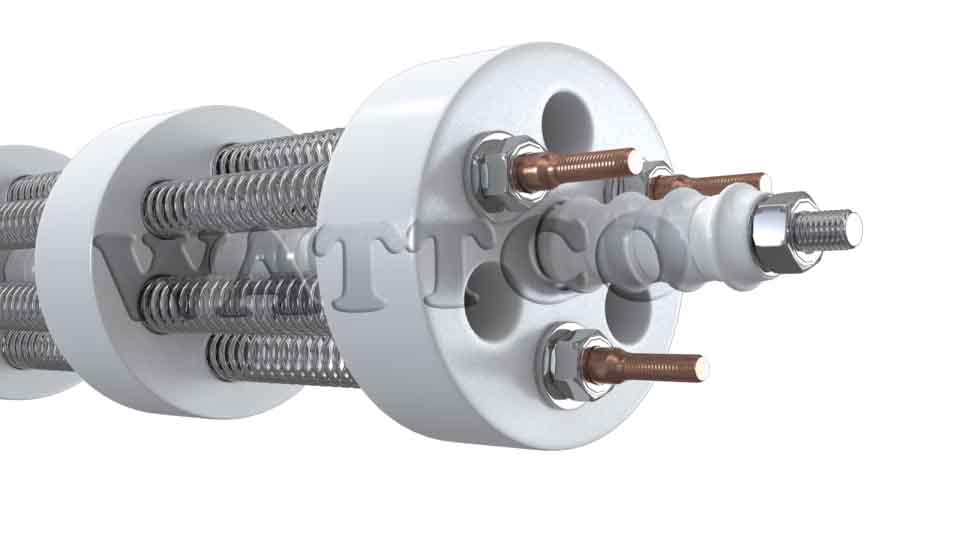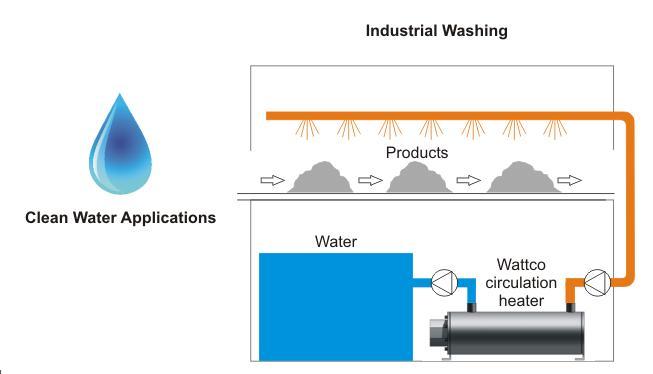Alternatives to Direct Immersion Heaters
- Prevent solidifying or freezing.
- Maintain the minimum viscosity to pump the liquid.
- Initiate a reactor or maintain the chemical feed at a temperature effective for reaction.
- Provide heat for the fluids within the closed circulation system of heat transfers.
- Immersion heater alternative
A typical method that provides tank temperature heating and maintenance is to tap into an existing source of energy within the plant, such as a heat transfer or steam system loop. The coils could be wrapped around a vessel or tank to make up any heat losses. This method could also impart heat into a vessel or tank for processing.
When a heat transfer or steam heat source is not easily available or installation is too costly, electric heat may be an option. The electric heat to provide external warming of tanks is accomplished by an external source, which is typically heat tracing in some form or another.
Heat tracing is most often used to prevent freezing of pipes or lines, and occasionally tanks. On a large tank; however, the use of heat tracing could be very costly. Because it is an external heat source, it can be used most efficiently to make up any losses, instead of providing the additional heat to raise the content of a tanks temperature.
Alternative to direct immersion heaters are circulation heaters, indirect immersion heaters, heat exchangers, and electric infrared heaters.
Circulation heaters: They heat liquids, and gases while circulating them through a closed loop provide control, and reduce the risk of contamination.
Indirect immersion heaters: They use a heating element inside a sheath or jacket, transfer the heat to the medium indirectly, and are suitable for corrosive or viscous fluids.
Heat Exchangers: It transfers the heat between two mediums efficiently without direct contact and is used in industrial and HVAC applications.
Electric Infrared Heaters: They provide targeted heating without direct immersion and are feasible for surface or localized heating needs.
Direct Source Immersion Heaters
An immersion heater normally has a tubular heating electric element bundled and welded to the NPT threaded fitting or the ANSI flange. That heater is then installed into a mated size nozzle that is near the tank’s bottom. These types of heaters are essentially 100 percent effective as the heat generated is applied directly to the fluid.
One possible drawback of the direct immersion heater is the possible corrosion to the heater sheath. Even when every attempt to mitigate corrosive risk is made, occasionally a direct immersion heater should not be used due to a risk of corrosion, depending on the fluid present and the sheath’s composition.
Another possible drawback could be contaminant buildup upon the element’s sheath. This normally occurs when an accumulation of minerals from carbon deposits while heating water, oils, or any organic chemical. This can cause the heater’s elements to constantly operate at a higher temperature internally, thus reducing service life.
Still another drawback could be removing the immersion heaters for replacement or service could mean a necessity to drain the tank. This could be cost prohibitive for numerous tank applications.
One method of overcoming a tank drainage issue would be to install the immersion heater as an exterior tank heat distribution system. This system would consist of the circulation heater, which contains an immersion heater, a strainer, pump, isolation valve, a sensor for positive flow, and any other necessary sensors or instruments.
Frequently, the control panel will be supplied with its own skid frame for operational control. The tank’s liquid is then circulated through a heater until the tank’s content reaches desired temperature. The fluid could be circulated continuously to maintain the tank’s temperature or an on/off control could be used to keep temperatures within a specific range.
In this setup, an advantage could be gained by not having to remove the heater for necessary maintenance; therefore, there is no need to drain the tank. A disadvantage is realized through higher overall costs compared to a direct immersion heater or an indirect method of heating. Additionally, the drainage of the circulation vessel is necessary prior to the electric heater’s bundle removal. Therefore, the drained fluid’s storage and/or disposal still leads to some associated costs.
Tank Heating by Indirect Immersion
A pipe with a closed-end is immersed into the fluid tank and the heater element heats the air inside the pipe creating what amounts to an oven. The heat radiates into the drywell, transferring the heat through convection to the fluid outside the drywell inside the tank. The advantage of a drywell indirect immersion heater is that the fluids do not come in contact with the heating elements, thus there is no chance of contamination or corrosion. The disadvantage is the higher cost than a direct immersion heater overall.
The advantage of a drywell indirect immersion heater is that the fluids do not come in contact with the heating elements, thus there is no chance of contamination or corrosion. The disadvantage is the higher cost than a direct immersion heater overall.
Two predominant styles of the drywell heater are a direct attachment or the weld-in-place. The direct attachment is normally attached to the tank nozzle, whereas the weld-in-place is most often added to tank during modifications or fabrications so that the drywell can be inserted into a hole in the tank and welded in place, as the name would imply.
A direct attachment method to the tank nozzle is preferred for a retrofit application. A mated thread fitting or a flange can be attached to a drywell to mate to the existing nozzle without alterations to the tank structure. Whichever case you prefer; the drywell should be set up four to six inches from the tank’s bottom.
Applying the Drywell Heater
Prior to deciding on a drywell heater over a different type of heater, direct or indirect, assess the probable failure costs. Does the added expense of the chosen heater outweigh the logistical inconvenience to gain access (through draining) to direct immersion heaters when replacement or maintenance is necessary? Some resource aspects to consider are:
ü The tank size and liquid storage or replacement
ü The heater’s cost, physical size, life expectancy, and the cost of installation
ü Safety concerns, such as toxicity or corrosion during drainage or replacement
ü Downtimes during processing and product loss or spoilage
ü Necessary equipment and personnel requirements during transfer and service
In summary, the use of direct immersion heaters is always the preferred method to an indirect method, when practical or possible. Heater costs and size are minimized. Additionally, virtually all power is generated to heat the fluid.
Nonetheless, if a heater needs to remain segregated from the fluid because of sheath contaminant or corrosion concerns, or the necessity to service or remove the heater without drainage of the tank, a drywell heater might be a viable alternative.

